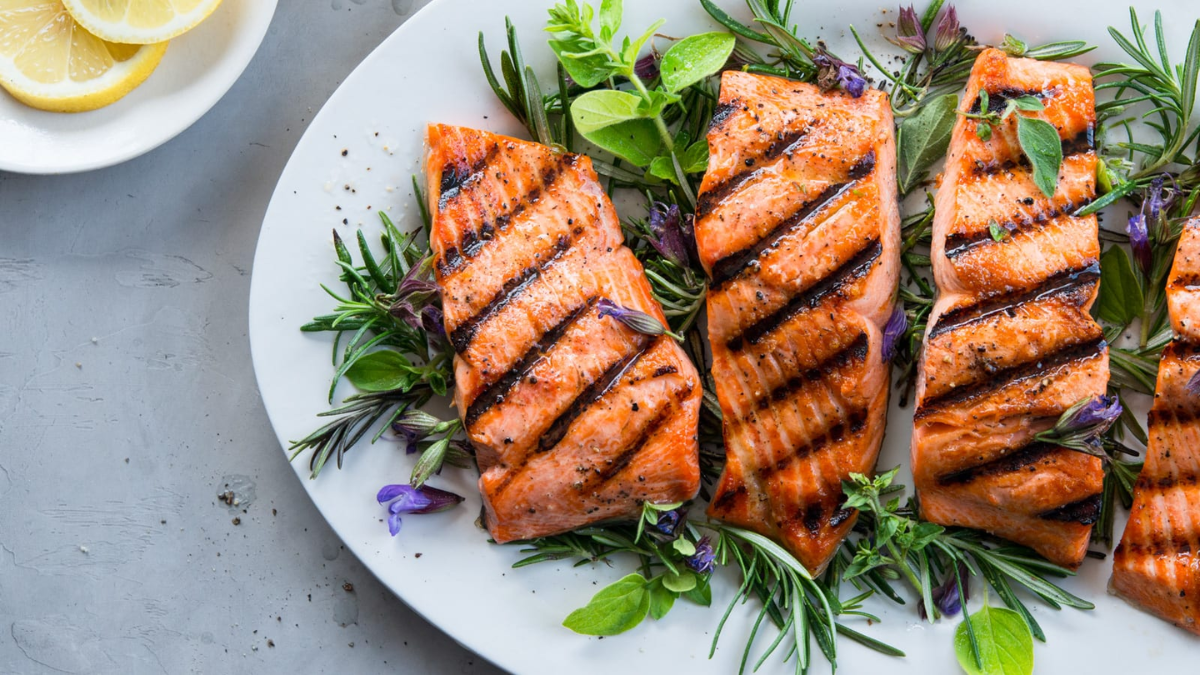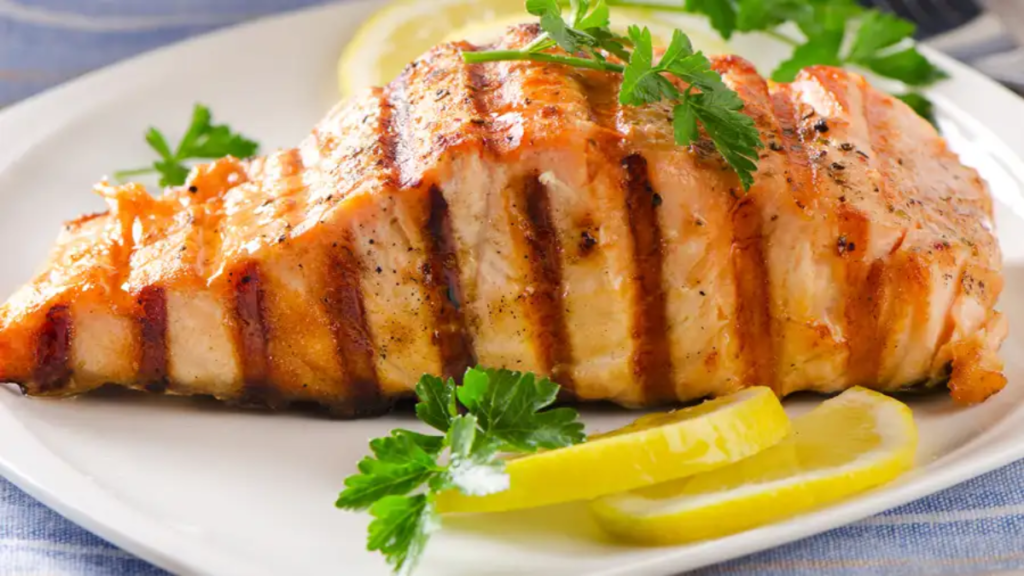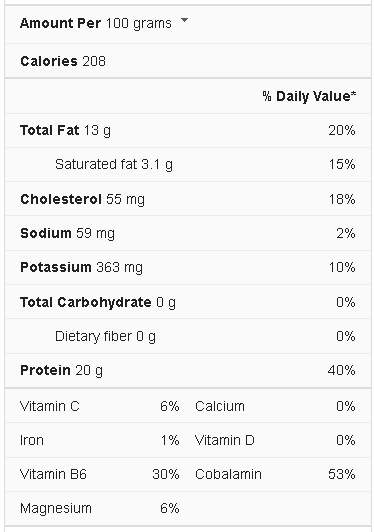Learn how to grill tasty, juicy salmon that’s excellent for adding to your favorite dishes or serving as a main dish protein! In this simple article, you’ll learn how to make excellent grilled salmon in under 30 minutes by using the direct grilling method and the foil pack method for making the tastiest grilled salmon. Recipes, marinades, and seasonings are all included! With warmer weather comes grilling season, and salmon is one of the simplest things to make on a grill, whether gas or charcoal. However, there is a secret to grilling salmon that, once learned, will change the way you cook this fish forever.
If you follow a few basic procedures, salmon is one of the quickest and easiest (and most delicious!) meats to grill. The grilled salmon dish uses only the most basic flavors (salt and pepper), so you may serve it in various ways.
Salmon Nutrition Facts
How To Grill Salmon?
Grilling salmon is straightforward if you follow a few simple instructions. Working with skin-on salmon pieces is required for this no-flip approach. Do you have any skinless salmon fillets on hand? Form a thin barrier between the fish and the grill with aluminum foil. The skin or foil coating (the cooking oil) will keep the fish from sticking and overcooking. It’s also essential to keep the grill clean to avoid sticking, so scrape the grates well.
While many people believe that king (or chinook) salmon is preferable, other species such as sockeye, coho, and even pink salmon are as great on the grill. Whether you’re grilling individual fillets or a whole side of skin-on salmon at once, plan on roughly 6 ounces of salmon per person. Spice rubs, glazes, and sauces can all be added as desired. Serve with grilled asparagus, potatoes, cilantro lime cauliflower rice, or other sides.
Ingredients
- 4 (6-ounce) skin-on salmon fillets
- Two tablespoons of canola oil (or vegetable oil), divided
- 1/2 teaspoon sea salt
- 1/4 teaspoon ground black pepper, optional
- Four lemon wedges, optional
Steps To Make It
- Gather the ingredients.
- Check to see if your grill is clean. Apply a thin layer of oil to the cooking grate—1 or 2 tablespoons should suffice—Preheat the grill to medium-high (charcoal, gas, or electric). Before moving your palm away from the heat, you should be able to hold it approximately 1 inch over the cooking grate for 3 to 4 seconds. A properly hot grill will keep the fish from sticking too much while gently and thoroughly cooking it without setting it ablaze.
- While the grill heats, prepare the salmon fillets. Rinse them and pat them dry.
- Remove any pin bones with tweezers. For the smoothest outcomes, pull them out in the same direction they’re coming out. Are there no pin bones to be found? You’ll feel them if you run your finger down the “seam” of the fillet.
- Another 1 to 2 tablespoons of oil should be brushed onto the cooking grate. Brush the remaining oil over the four fillets and season with salt and pepper.
- Cover the salmon with foil and place it skin-side down on the hot grill. Cook undisturbed until the salmon releases its fat (opaque mayonnaise-like substance) or reaches 145 degrees Fahrenheit, which takes about 15 to 20 minutes for most 1-inch-thick fillets. Allow 5–10 minutes for each additional inch of thickness. Remove the fish from the grill with a spatula.
- Serve the grilled fish right away. Serve with lemon wedges for people to spritz their salmon with fresh lemon juice, or serve with your favorite garnish.
Can You Eat Salmon With Skin?
Salmon skin is generally regarded as safe to consume. The skin of salmon provides more of the same elements and nutrients, making it a fantastic supplement to any diet. When deciding whether or not to consume the salmon skin, consider the source and quality of the fish. When determining whether or not to consume the salmon skin, personal preference may play a role.
Salmon skin is a delectable and nutritious complement to any diet. It has a higher concentration of the same protein and critical omega-3 fatty acids found in fish. The body does not produce Omega-3 fatty acids, so they must be obtained from food. Salmon also has a high concentration of vitamins B and D and vital minerals like selenium.
The US Food and Drug Administration (FDA) recommends that people, especially women aged 16 to 49 and children over two, consume 2 to 3 servings of oily fish each week. Leaving the skin on may give the body additional nutrients. Although some individuals find the skin unappealing, those who opt to leave it on find their favorite recipes work just as well.
What Are The Benefits Of Eating Salmon?
Salmon can only survive in the frigid waters of the ocean. To keep the salmon warm in the ocean, their skin includes many omega-3 fatty acids. These fatty acids may also be beneficial to the human body’s health.Omega-3 fatty acids may protect the heart from heart disease risk factors, such as high blood pressure. They may also help protect the brain from degeneration, the skin drying out, and the eyes from macular degeneration caused by age.
According to a study published in the journal Marine Drugs, Salmon skin may also help treat type 2 diabetes. When salmon skin was provided to test subjects, it appeared to have the tremendous antioxidant ability and may even aid with wounds caused by diabetes.Omega-3 fatty acids appear to play a role in cancer prevention, according to another study published in BMC Cancer. Omega-3 polyunsaturated fatty acid-rich diets may aid in the battle against cancer cells. Salmon skin also offers more protein to the diet, which may benefit those looking for a meat substitute.
Some Side Dishes To Salmon
Although there are a lot of sides to salmon, Here are some of the best sides of salmon.
Lemon Pasta
Let’s start with a basic dish that packs a punch of flavor. This lemon pasta is light and delicious, and it only takes 15 minutes to prepare! The sauce for this pasta is composed of lemon, cream, and white wine, and they create a fantastic entrée when combined with al dente pasta. With a slice of crispy pan-fried salmon on top, you’ll have a filling and nutritious meal.
Buttery Garlic Green Beans
Beans that are sweet and crisp on their own are delicious, so you don’t need much to make them stand out. All you need for this dish is butter, garlic, and lemon zest. You can already smell the scent simply by thinking about it! The use of fresh ingredients is the secret to this gorgeous side dish. Your dish will taste better if your beans and garlic are fresh. Serve your buttery garlic green beans alongside pan-fried fish, and you’ve got a winner! For the family, you’ll prepare a nice lunch.
Roasted Parmesan Rosemary Potatoes
Roasting potatoes is the best way to make them taste better. Putting potatoes in the oven is like casting a spell, and both the flavor and texture of your potatoes will improve! Do you know what enhances the flavor of roasted potatoes? Garlic, parmesan cheese, and rosemary are the three ingredients. This mix of components is incredible. I’m not sure where to begin. They make the potatoes taste delicious—crisp on the outside, fluffy on the inside, and flavorful on both sides. Ecstasy personified. Serve this delectable side with baked salmon for a delicious supper.
Lemon Butter Broccoli
Broccoli isn’t as well-known as its cousin, so don’t dismiss it yet. This cruciferous veggie packs a punch. Here’s a quick history lesson: broccolini was first introduced in 1933. It’s the result of a broccoli-Chinese broccoli crossbreeding. It has long stems, but its florets are significantly smaller. They don’t lack flavor just because they’re little. In reality, all you need is lemon and butter to make it a delicious salmon side dish!
Cilantro Lime Rice
Rice isn’t the most thrilling side dish available. On the other hand, Cilantro lime rice is an entirely different story. It’s created with basmati long grain rice fried in olive oil and seasoned with cilantro and lime before being fluffed to perfection. This dish is easily comparable to Chipotle’s. Serve with salmon for a spectacular supper. This side dish is so addicting that you may reach for the bowl for a second, helping! Don’t worry, and I’m not going to judge you.
Which Color Is Salmon Best?
As with all salmon, pinks fished in the ocean are the best. On the other hand, Pinks aren’t known for their culinary prowess. Their meat is grayish-pink while fresh before it deteriorates as the fish swim upstream to reproduce and die. On the other hand, red salmon is healthier than pink salmon because it contains more heart-healthy omega-3 fatty acids and B vitamins. Red salmon has a more considerable amount of B6, B12, B5, thiamin, riboflavin, niacin, folate, vitamin A, calcium, and zinc than white salmon.
Conclusion
Dry the salmon fillets thoroughly with paper towels before lightly brushing them with oil. Season the salmon all over with salt and pepper just before cooking. Then place the skin-side down on the grill’s hot side. Cook for about 4 minutes, or until the skin is browned and crispy, and the salmon easily slides off the grill. Place the salmon on the grill, skin-side up, at an angle across the pan’s ridges—Cook for 3 minutes, or until the fish has noticeable grill marks. Use a spatula to reposition the fillets roughly 45 degrees to generate cross-hatched grill markings (keep the skin-side up). This is a simple, tasty, and healthful meal.


